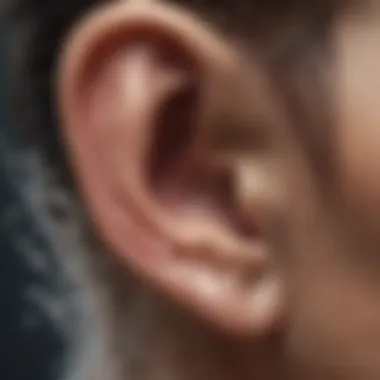Effective Methods to Remove Water from the Ear


Intro
Water in the ear can be a pesky issue, especially for those who frequent the waves or poolside. This article delves into various methods to tackle this common problem, equipping surfers, instructors, and beach lifeguards with the knowledge they need to handle trapped water safely. Whether you’ve just come back from a surfing weekend or finished an exhausting swim practice, the discomfort of water stuck in your ear shouldn't linger longer than necessary.
Though often not serious, trapped water can lead to an array of complications like ear infections or swimmer's ear if left unaddressed. Understanding not only how to remove water but also recognizing the importance of ear health forms the backbone of our discussion here.
We will explore practical solutions ranging from simple gravity-assisted techniques to more complex medical interventions. Additionally, we will highlight key preventive measures to keep those auditory canals clear before they get blocked up, ensuring a smooth experience in your aquatic endeavors.
This will serve as a comprehensive guide, empowering you to tackle this annoyance effectively. The next steps in this guide will lay out the various techniques available, how to appropriately apply them, and when to seek professional advice.
"The trouble with water trapped in the ear is that it can muddle your day, but knowing how to release it can clear the way for better enjoyment at the beach."
Understanding the Problem
Trapped water in the ear often stems from immersion in water — be it surfing, swimming, or just a splash at the beach. The ear canal might collect moisture that can become stuck, particularly if the water doesn’t exit naturally due to various factors, like anatomical differences in ear shape. This moisture can cause discomfort or, worse, lead to ear infections if persisting over time.
Here's a quick rundown of symptoms to look out for:
- Sensation of fullness in the ear
- Discomfort or mild pain in the ear
- Hearing issues, like muffled sounds
Taking action as soon as you notice these signs is crucial. In the following sections, we will outline the effective methods one can utilize to clear out that stubborn water.
Understanding Trapped Water in the Ear
Experiencing water trapped in the ear can be an annoying and uncomfortable situation, often arising after a good swim or a fun day at the beach. This predicament is not just a minor inconvenience; it can lead to various complications if not addressed promptly. Understanding this issue is paramount for everyone who engages in aquatic activities, including surfers, instructors, and lifeguards. The more you know about how trapped water occurs and how it can affect you, the better equipped you'll be to deal with it effectively.
Anatomy of the Ear
To grasp how water gets trapped in the ear, it's beneficial to know a bit about ear anatomy. The ear comprises three main sections: the outer ear, middle ear, and inner ear.
- Outer Ear: This includes the visible part, known as the pinna, and the ear canal, which leads into the eardrum.
- Middle Ear: Behind the eardrum lies the middle ear, containing air and three small bones called the ossicles that assist in sound transmission. It connects to the throat via the Eustachian tube.
- Inner Ear: This part houses the cochlea (important for hearing) and the vestibular system (critical for balance).
Trapped water usually lodges in the outer ear canal, occurring after showers, swimming, or diving. The ear canal is shaped like an 'L'—which can be a contributing factor when it comes to draining. Its curvature may prevent water from escaping.
Common Causes of Trapped Water
Several factors can lead to water becoming trapped in the ear. Here are the most common:
- Swimming and Surfing: Active engagement in water sports often immerses the head underwater, allowing water to enter the ear canal.
- Showering or Bathing: Even simple washing can sometimes result in unwanted water making its way into the ears.
- Sinus Pressure: Blockage in the Eustachian tube due to sinus congestion can create an imbalance and cause water to be trapped.
- Earwax Build-up: Ironically, wax is needed for ear health, but excessive build-up can trap water.
Being aware of these causes can help individuals take preventive measures. Whether it’s wearing earplugs while surfing or dodging certain head positions in the water, understanding the nuances of this condition is crucial. Keeping informed facilitates not just immediate solutions but also long-term ear health, reducing potential complications from trapped water.
Symptoms of Water-Trapped Ear
Understanding the symptoms associated with water trapped in the ear is essential for anyone who spends time in aquatic environments. Recognizing these signs early can make a significant difference in how quickly you can address the discomfort and prevent complications. Ignoring symptoms can lead to infections or further discomfort, underscoring the need for awareness and education in this area.
Common Sensations Experienced
When water gets stuck in your ear, the sensations can be quite annoying. Many people describe feeling a fullness in the ear, similar to having your ears pop during altitude changes. This sensation can alter the way sounds are perceived, leading to a sort of muffled hearing.
In addition to that, you might experience mild discomfort or even a bit of pressure, as if there's a weight pressing inward. These sensations can vary from person to person, but some common feelings include:
- Fluid movements: You may feel the water sloshing around when you move your head.
- Itching or irritation: While frustrating, this can be a sign that the trapped water is affecting the ear canal.
- Underlying pain: If left untreated, the lingering water can contribute to more severe discomfort or pain.
These feelings are usually temporary, but they’re crucial indicators that something's amiss. Pay attention to how long these sensations last. Persistent symptoms might suggest further action is needed.
When to Seek Medical Assistance
Recognizing when it's time to consult a medical professional is a vital part of dealing with water trapped in the ear. If you're experiencing any of the following signs, it might be wise to reach out for help:
- Persistent discomfort: If the fullness or pain doesn’t subside after a day or two, don’t wait around. Consult a healthcare provider.
- Fever symptoms: A fever can indicate an infection. If your temperature rises, it's more than just trapped water.
- Discharge from the ear: Any leaking fluid, especially if it's yellow or has an odor, warrants a visit to a medical professional; it could mean an infection is developing.
- Hearing difficulties: If your hearing remains dulled or you're experiencing any sharp pain, it's best to get checked out.


In some instances, the trapped water can lead to complications like otitis externa, commonly known as swimmer's ear. This condition arises when bacteria or fungi infect the ear canal. Therefore, recognizing these signs and seeking timely medical advice is crucial to avoid any potential long-term damage.
Remember: Early intervention can prevent more serious issues later on, so if in doubt, don't hesitate to consult a professional.
Prevention of Water Entrapment
Water trapped in the ear can lead to discomfort and even infections, making prevention an important aspect of overall ear health. Understanding how to keep your ears dry during water-related activities is crucial. Not only does this help to avoid the complications that arise from trapped water, but it can also enhance enjoyment while swimming or surfing. As such, incorporating preventive measures into your routine is a smart approach.
Using Earplugs or Caps
Choosing the right ear protection can make all the difference when it comes to keeping water out of your ears. Earplugs designed specifically for swimming can create an effective barrier against water entering the ear canal. These are typically made from soft silicone or rubber, allowing for comfort and a snug fit.
When selecting earplugs, look for options that are waterproof and have a good sealing feature. This is particularly important for individuals who engage in regular water activities like surfing or swimming. A well-fitted earplug not only keeps water out but also minimizes the noise, so you can focus on your performance in the water.
Caps for swimming serve a similar purpose, providing coverage for both the ears and hair. For those with longer hair, a swim cap can reduce drag and prevent hair from becoming a tangled mess in the water. It's also worth noting that swim caps can be a stylish accessory, combining functionality with personal flair.
However, it's essential to ensure that earplugs or caps are used correctly. Improper use may lead to discomfort or make the situation worse. Always read the instructions and practice proper hygiene to avoid ear infections caused by trapped moisture or bacteria.
Techniques for Water-Safe Activities
Being mindful of how you engage in water activities can significantly reduce the risk of water entrapment. Simple techniques can go a long way in ensuring that water remains outside where it belongs.
- Head Positioning: When diving or submerging your head, keep your head tilted downwards. This allows gravity to assist in keeping water from entering your ear canal.
- Controlled Breathing: Exhaling through your nose while your head is submerged can help change the pressure in your ears, reducing the likelihood of water getting trapped.
- Avoid Overexertion: Take breaks when needed. Exhaustion can lead to careless movements which can increase the chances of water getting in your ears.
Water-related activities can also be controlled by choosing calmer environments when possible. For instance, practicing swimming in a pool with minimal waves or taking a surf day on calmer seas can help ensure that your ears remain drier.
It's crucial to be proactive in preventing water from entering your ears; prevention is often easier than remedying the situation later.
Taking these straightforward steps can vastly improve your experience in the water and reduce the chances of trapped water. By using earplugs or caps, and adopting safe water techniques, you can enjoy your time without the nagging worry of water getting stuck in your ears.
Gravity Techniques for Water Removal
When it comes to easing the discomfort of trapped water in the ear, gravity techniques often take center stage. This approach can serve as an introductory method to tackle this common nuisance, especially for folks who frequently find themselves around water, such as surfers and lifeguards. Harnessing gravity is not just about moving fluid; it’s about understanding the body's natural mechanics and using it as an ally.
The beauty of gravity techniques lies in their simplicity. They don’t require any special equipment or medication—just your body and a few easy movements. This accessibility is a major advantage for anyone who needs a quick fix while on the go. Moreover, when done correctly, these methods can significantly reduce the likelihood of complications associated with trapped water.
Tilt and Pull Maneuver
One of the most effective gravity techniques is the tilt and pull maneuver. While it might sound a bit simplistic, its effectiveness can surprise even seasoned beachgoers. Here’s how it works:
- Find a comfortable position—either standing or sitting.
- Tilt your head to the side of the affected ear, allowing gravity to assist in pulling the water out.
- Gently tug on your earlobe while keeping your head tilted. This can help create an opening in the ear canal, allowing trapped water to escape more easily.
To see significant results, the key is to be patient and repeat the process if necessary. Some get it right on the first try, while others may need a few attempts. Just remember, don’t rush it; the water has its own pace to flow out. If you find success on your first go, it’s certainly worth a pat on the back.
Jaw Movements
Another method that deserves attention is the use of jaw movements. This technique may sound a bit quirky to some, but it leverages simple anatomical movements to your advantage. The idea is straightforward yet effective:
- Begin by opening your mouth wide and then swiftly moving your jaw in a side-to-side motion. This can help shift the pressure in the ear and promote drainage.
- Some people also find it helpful to mimic the action of chewing gum. Not only does it look amusing, but it might just be the nudge your ear needs to free itself from the watery clutches.
- You can also try yawning or sucking in your cheeks. Both actions can create subtle differences in pressure that encourage trapped water to make its way out.
Here’s a tip: if attempting the jaw movement exercises becomes uncomfortable, take a breather and give it another shot a little later. Everyone’s body reacts differently, and sometimes your ear just needs its own time to respond.
"Embracing simple techniques like these can sometimes offer relief that feels both effortless and gratifying."
While gravity techniques may not always be the end-all solution, they serve as a valuable first step in managing trapped water in the ear. Together with a greater understanding of ear anatomy and function, these methods can empower surfers and those in aquatic professions to address common ear issues with confidence.
Hydration Techniques Using Heat
Heat can play a significant role in facilitating the release of trapped water in the ear. This approach is rooted in the premise that warmth helps to expand the ear canal and promote relaxation of the tissues, allowing trapped moisture to escape more easily. Ultimately, using hydration techniques that incorporate heat not only aims to alleviate discomfort but also helps prevent further complications from water retention.
Utilizing heat can be particularly beneficial for individuals who have engaged in water-filled activities. Surfers, for instance, may find that post-session, moisture lingers in their ears, potentially leading to discomfort or even infections. Applying heat to the area can help mitigate these issues, providing a gentle yet effective remedy.
Applying a Warm Compress


One simple yet effective way to employ heat is through the application of a warm compress. To do this, start by dampening a clean washcloth in warm water – make sure it’s not too hot to avoid burns. Once it's at a comfortable temperature, wring the cloth out to remove excess water.
Next, position the warm compress against the affected ear for about 5 to 10 minutes. The warmth from the compress helps to loosen the trapped water and encourages drainage.
Furthermore, it’s important to ensure that the ear isn't filled with water as you apply heat. Here are some tips to keep in mind:
- Keep the compress at a comfortable temperature. Avoid extremes that might irritate the skin.
- Stay relaxed. Find a position that allows you to be comfortable during the process; for example, laying down on your side with the affected ear facing up may assist gravity in aiding drainage.
- Repeat as needed. You can conduct this method several times a day if you continue to feel discomfort or pressure.
Steam Inhalation Benefits
Steam inhalation can be another effective method to facilitate ear water release. While many think of steam primarily for respiratory ailments, it can also be beneficial for ear health. When steam disperses into the air, it mixes with the surrounding environment and helps to open up the eustachian tubes – those little passages connecting the throat and the ear.
To perform steam inhalation at home, you can follow these steps:
- Boil Water: Bring a pot of water to a gentle boil.
- Create a Safe Space: Off the heat, place a towel over your head and lean over the pot, allowing the steam to envelop your face and ears.
- Breathe Deeply: Inhale through your nose and allow the steam to work its magic. Doing this for around 10-15 minutes can provide considerable relief.
It’s essential to remember that both warmth and steam can provide comfort, but they also must be approached with caution. Scalding heat can cause burns and other injuries, so it’s best to find a balance.
"A little warmth goes a long way in helping ease the discomfort of trapped water, especially for those who brave the waves often." - Anonymous
Using hydration techniques that involve heat is a time-tested approach worth considering. As simple as it may seem, this method may offer both comfort and relief. By embracing practices such as warm compresses and steam inhalation, individuals can foster better ear health, especially after soaking activities.
Manual Removal Methods
Manual removal of trapped water in the ear can serve as a practical solution for those unexpected moments when water seems stubbornly held captive in the auditory canals. Understanding various manual techniques can empower individuals to address this common issue safely and effectively.
Among the myriad of strategies available, manual methods often come first to mind. They are generally straightforward and can be performed at home with minimal equipment. Importantly, using manual techniques can help avoid complications that may arise from unintentional misuse of tools or harsh substances that might irritate the ear further.
Here's what to keep in mind:
- Simplicity: Many manual methods do not require purchases of specialized products.
- Accessibility: Most techniques can be executed solo or with a partner, providing flexibility for when assistance is necessary.
- Immediate Results: These approaches can yield quick relief, perhaps even while waiting for an appointment with a healthcare professional.
The following sections will delve into two distinct manual techniques suitable for effective water removal.
Over-the-Counter Solutions
When it comes to dealing with water trapped in the ear, over-the-counter solutions offer a convenient and effective way to address the issue. The ease of access without needing a prescription makes these remedies appealing, especially for surfers, beach lovers, and all those who frequently find themselves in water. These solutions can help to promote ear health, especially when regular swimming or water activities lead to persistent moisture that lingers longer than desired.
One must consider the composition and purpose of these topical solutions; many are designed to evaporate moisture and provide relief from discomfort. Better understanding these products can empower users to choose wisely—maximizing benefits while minimizing the need for medical intervention.
Ethanol and Acetic Acid Drops
Ethanol and acetic acid drops have gained popularity as one of the go-to remedies for removing trapped water. The alcoholic component helps to evaporate the water swiftly from the ear canal while also creating an acidic environment that can discourage bacteria growth. Essentially, this dual-action property can mitigate the chances of developing an infection, which is often a risk when moisture is trapped for extended periods.
Benefits of Using Ethanol and Acetic Acid Drops:
- Fast evaporation: The alcohol content promotes quick drying; this is crucial for those who want to resume their water activities without delay.
- Prevention of infections: The acidic nature acts as a deterrent against unwanted bacterial growth.
- Ease of application: Typically available in dropper bottles, they can be administered directly into the ear canal.
However, one must exercise caution. If users experience any irritation or unusual symptoms after using these drops, it might be wise to cease usage and consult a healthcare professional.
Hydrogen Peroxide Use
Hydrogen peroxide is another commonly utilized solution in over-the-counter ear care products. Its bubbling action when introduced into the ear canal not only aids in cleaning but also serves to dislodge any debris or trapped water. The effervescence helps attract the moisture towards the ear outwards as it breaks down wax and clears any blockages.
The Pros of Hydrogen Peroxide:
- Versatile cleaning: It’s effective in cleaning earwax as well as helping with moisture removal.
- Bubbly action: The fizzing action is not just satisfying; it's instrumental in flushing out what can be stuck fast in the ear canal.
- Widely available: This compound can easily be found in most pharmacies, making it an accessible option.
Despite its merits, users should be aware that using hydrogen peroxide excessively can irritate the ear canal lining. Therefore, it’s essential to follow instructions diligently and consider seeing a doctor if symptoms do not improve or worsen.
"Simple solutions, when used wisely, can make a world of difference, especially when it comes to maintaining ear health during all your aquatic adventures."


In summary, over-the-counter solutions such as ethanol and acetic acid drops or hydrogen peroxide must be viewed as part of a broader strategy for managing ear health. When utilized correctly, these methods can support your quest to keep your ears clear of trapped water and prevent complications.
When to Consult a Professional
Addressing trapped water in the ear can often be managed with home remedies and over-the-counter solutions. However, there are instances when seeking professional medical help becomes essential. Understanding these circumstances can literally be the difference between a simple irritant and a serious complication.
Recognizing Signs of Infection
One of the most pressing reasons for consulting a healthcare provider is the possibility of an ear infection. Particularly if trapped water persists for an extended period, several symptoms might signal that an infection is brewing. Look out for:
- Persistent pain or discomfort in the ear, which could range from a mild annoyance to severe pain.
- Fever, especially in children, can be a tell-tale sign that the body is fighting an infection.
- Discharge, such as fluid leaking from the ear. This can indicate a more serious issue.
- Hearing changes, such as muffled sounds or an unusual sensation.
These symptoms shouldn’t be dismissed lightly. They often indicate that your body's defense mechanisms have kicked in, and ignoring them could lead to more serious health issues.
"Ignoring ear discomfort is like ignoring a storm on the horizon—better to seek shelter before it hits you."
Promptly addressing any signs of infection not only facilitates quicker recovery but can also prevent the condition from worsening. It’s essential to act on these signs because complications, like hearing loss or more severe infections, can arise when treatment is delayed.
Potential Referrals to Specialists
Should you find yourself in a situation where an infection or other issues are confirmed, your general practitioner may refer you to an ear, nose, and throat (ENT) specialist. Here are some considerations that may prompt such a referral:
- Chronic issues: If you repeatedly suffer from trapped water or infections, specialist intervention becomes pertinent to explore underlying causes.
- Surgical options: In some cases, surgical procedures, such as myringotomy, might be necessary to relieve pressure and drain fluid.
- Hearing assessments: Persistent trapped water can affect hearing. An ENT can provide a comprehensive evaluation, including audiometry tests.
In essence, consulting a professional equips you with a thorough understanding of your ear health and ensures you can take the right steps to reclaim your auditory well-being.
Long-term Ear Health Considerations
When it comes to maintaining ear health, especially after experiencing trapped water, being proactive is crucial. Chronic issues can lead to complications that are far from benign. Engaging in regular practices focused on ear hygiene can save a great deal of discomfort and potential medical intervention.
Routine Ear Cleaning Practices
Routine cleaning of the ears may sound like a simple task, but it is one many people overlook. Having a consistent method can help minimize the chance of water accumulation, wax build-up, and even infections. There are a few effective approaches:
- Warm Water Rinse: Gently rinsing the ear with warm, not hot, water during a shower can help flush out residual water after swimming or other water activities. If you hear a little squeak or a rush, you know good ol' Mother Nature's helping out.
- Drying Methods: After water activities, consider using a soft towel to dry the outer ear. Avoid inserting anything into the ear canal, as it risks pushing wax deeper.
- Ear Drops: Over-the-counter ear drops designed to help dry out water trapped in the ear can also serve as a regular practice. These can keep the ears in check if used judiciously.
These practices can significantly reduce the likelihood of encountering severe issues later, such as swimmer’s ear — a condition that nobody wants on their plate.
Importance of Regular Check-ups
Regular check-ups with a healthcare provider can be instrumental in preserving ear health. Many individuals neglect this, thinking their ears are fine. Truly, prevention is better than cure. Some reasons why these check-ups should not be missed include:
- Early Detection: Any signs of infection or abnormality can be identified early, which is vital for effective treatment. Like catching wind of a storm before it hits land, early detection can prevent larger issues.
- Professional Cleaning: A healthcare provider can perform a thorough cleaning that not only removes wax but also inspects the ear for potential problems that you might miss at home.
- Personalized Advice: Every individual is different. Depending on life circumstances — like if one is often in the ocean or a pool, having a pro assess one's ear health can lead to tailored advice that suits personal needs.
"An ounce of prevention is worth a pound of cure."
In sum, the road to long-term ear health is paved with routine practices and regular check-ups. Keeping ears clean and making healthcare visits a habit can result in a lifetime of comfort and reduced risks. Whether you're riding waves or simply enjoying a day at the pool, being mindful of ear health is paramount.
Closure and Key Takeaways
In summary, understanding how to effectively release trapped water in the ear is crucial for those frequently engaging in aquatically-oriented activities. Water retention in the ear can lead not only to discomfort but also to more serious issues like infections if left unaddressed. This article elucidates various methods, reinforcing the notion that both preventative measures and remedial techniques play vital roles in promoting ear health.
Summarizing Effective Strategies
When it comes to effectively releasing trapped water, several strategies can be harnessed:
- Gravity Techniques: These simple methods, such as the tilt and pull maneuver or incorporating jaw movements, can often do the trick without any extra tools. Just a bit of ingenuity and body position can help dislodge that pesky water.
- Heat Applications: Utilizing a warm compress can ease the tension in the ear, allowing trapped water to escape more readily. Even steam inhalation plays a role by helping to expand the ear canal, potentially letting trapped water out.
- Manual Removal: Though careful, the use of a bulb syringe can provide an extra hand when needed. Just remember to avoid cotton swabs, which might drive the water further in.
- Over-the-Counter Solutions: There's no harm in reaching for specialized ear drops containing ethanol or acetic acid as these can effectively remove moisture, helping maintain a balanced ear environment.
By keeping a few of these strategies in your back pocket, you'll be better equipped to handle the issue of trapped water swiftly.
Encouraging Safe Practices
Safety should always be at the forefront of any approach to ear health. Here are a few key considerations to keep in mind:
- Routine Cleaning: Regularly cleaning your ears is pivotal. It’s not about deep cleaning every week but maintaining hygiene to prevent blockages.
- Check-ups: Don't overlook the value of routine medical check-ups, especially if you're a frequent swimmer or surfer. A professional can catch early signs of potential problems before they escalate.
- Listen to Your Body: If discomfort persists despite trying various methods, it may be time to consult a healthcare provider. Ignoring signs of infection or prolonged issues is not the way to go.
- Water Safety Gear: Equip yourself with quality earplugs or caps when swimming. It's a simple step that can pay dividends.
Remember, the ear is delicate. Using common sense and being proactive can save you from undue complications later on.
By following these guidelines, you’ll not only enhance your immediate comfort but also foster long-term ear health that supports your aquatic activities. So dive in with confidence, but keep these tips in your repertoire!















